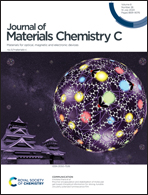Highly conductive porous graphene film with excellent folding resilience for exceptional electromagnetic interference shielding†
Abstract
The facile and controllable preparation of graphene-based materials with superb electromagnetic interference (EMI) shielding performance simultaneously integrating ultrathin, lightweight, flexible even foldable properties is still challenging. Here, porous graphene films (PGFs) with exceptional shielding capacity are easily and controllably fabricated via a confined foaming strategy and energy-saving method for the first time. The employment of an optimized graphene precursor with few defects enables PGFs to have not only an improved structure order but also an elevated mechanical strength and electrical conductivity. Meanwhile, an oriented and hierarchical porous architecture is finely constructed in PGFs, which endows them with a low density and an excellent folding endurance that does not change even after thousands of folding cycles. The strategically combined high conductivity and porosity give the PGFs an exceptional EMI shielding effectiveness (SE) of 43.8 dB due to the greatly enhanced hierarchical internal multiple reflections and dielectric loss. The PGFs exhibit a high specific SE/thickness of 29 178 dB cm2 g−1 and the highest graphene shielding efficiency among the previously reported graphene materials. Such outstanding EMI shielding property and their ability to be foldable render the thin and lightweight PGFs as promising materials for applications in foldable and wearable electronic devices.



 Please wait while we load your content...
Please wait while we load your content...